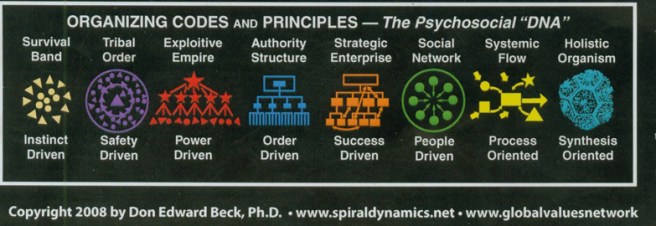
Old friend Rogers and the crew on the top of Snowbird, UT, March, 2018 — Mt. Timpanogos in the background
One of the things that is self-evident to the squirrels in my head, but seems at times elusive to others, is how the mean level of empathetic development of a group of people will create the social structure of a given community. Naturally there are cultural influences that are all up and down the Spiral v-Meme ladder that influence the actual behavior of the people in a given social structure — remember that our Theory of Everything includes cultural sidebars (as well as a host of other factors, including personal development) as well as social structure as primary drivers in human interaction. But empathy remains at the root of the social structure evolution.
How does this exactly work? Let’s go back to our Empathy Pyramid and do some word tagging that may give some insight into how all this works. Here’s the final Empathy Pyramid we left off when we introduced the notion of Conscious Empathy.

Now let’s add some understanding to how each level of empathy works, and make a new graph. On the right side, I’ve added a new column of behavior drivers that come out of each new level of the Empathy Pyramid. Let’s remember that with all things like this, we get a nested stack, meaning the levels below are included in each of the upper levels, so Emotional Empathy includes Mirroring Behaviors, and so on.

Empathy-Social Behavior Coupling Graph
Unpacking this, we can now see how empathy creates given social structures. It should be said that there are always fuzzy boundaries between the given levels — purity is not a function of the human (or rather, sentient) condition. Automatic behavior doesn’t do much for persistent social structure, so it’s no surprise it’s at the bottom with mirroring empathy. If you see one of your buddies running from a lion, you’re likely to take off and start running as well. But once the lion gets tired, there’s not much lingering social structure from the effect. Lots of individual emotions, but not much persistence.
Up a level, Evaluative behavior is a cornerstone of emotional empathy, as well as primary force driving people into the next two v-Memes — Tribal, and Authoritarian. First off, you have to evaluate who’s in your group/tribe, and who’s not. Next up, if circumstances are right, you’re likely to figure out who’s the boss. Is it the person who is most generous, or the person who can likely beat the next lion with a stick? Status matters uber alles, with ranking and submission naturally emergent. Everyone knows, in an Authority-based structure, if the boss is having a bad day. And that starts creating the tree-like social structure stack we associate with Authority-based social structures.
Rational empathy comes up next, introducing the concept of personality-decoupled classification (‘engineers think this way’/ ‘you know about those lawyers’) and that ability — the ability to predict what someone might say leads to the stacks of hierarchies in the Legalistic mode. But it doesn’t stop there. If you want to reach goals (Performance v-Meme) you’re going to start collecting data on potential individual high performers you want on your team, and connect with them, once again creating the variation in the organization chart that happens when it becomes important for people to accomplish work. And before you know it, the practice from that has caused you to bleed over into looking at people based on their individual characteristics — that good, old-fashioned Communitarian v-Meme.
As you age, and develop a more profound relationship with yourself, you know when you’re being virtuous, or being selfish. Conscious empathy becomes a tool for larger ends, and then allows you to go along with, or assemble the circumstance/social structure you need, mapping elegantly to the Global Systemic v-Meme, the first of Wilber’s Second Tier. And then, of course, once we’re on that level, we realize we’re just a little fish swimming in a very big pool, surrounded by all sorts of building block social structures that interplay with each other in all sorts of different ways. A human’s got to know their limitations — we can never jump out of the water high enough to really know exactly what’s going on. But we can feel the waves in the pool.
Hope this helps! Here’s Don Beck’s awesome little social structure sidebar so you can now understand and enjoy the interplay of the evolving empathy-driven story inside each of us, as well as our social organizations!

Agree. Empathy is the foundation of community. Empathy is the foundation of intersubjectivity.
Not only is the individual a part of the community, the community is also a part of the individual. This bears repeating. The “I” does not only belong to the “we”; but the “we” is a part of the “I.” We carry within ourselves a readiness for community, a readiness for relatedness, a sense of inclusion in community; and if there is no one else to talk to, we talk to ourselves.
The empathy lesson? Empathy is the foundation of relatedness, and resistance to empathy is resistance to relatedness. People are born into “relatedness.” Empathy is about participation with others. Empathy is about relatedness with other people and who these others authentically are in their strengths and weaknesses, in their possibilities and limitations. Even when a person is a hermit, all alone, he is alone in such a way that his aloneness depends on the basic condition of his being a creature designed for relatedness. Being unrelated is a privative form of relatedness; and being alone is a deficient form of relatedness. Paradoxically, nonrelatedness becomes a way of relating for some.
LikeLiked by 2 people
That’s a good recursive thought, Lou. I find it interesting how the empathy stack actually creates the org chart. With all the facets, it is really the root of everything.
LikeLike